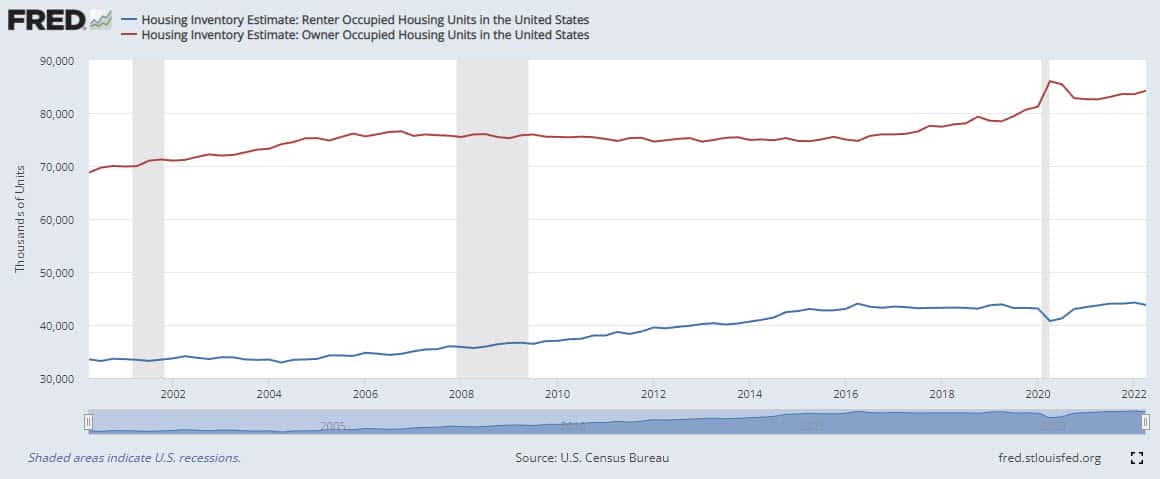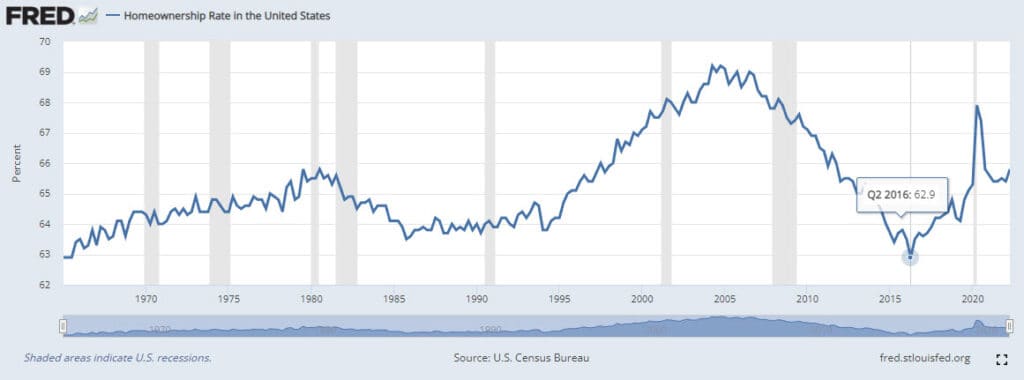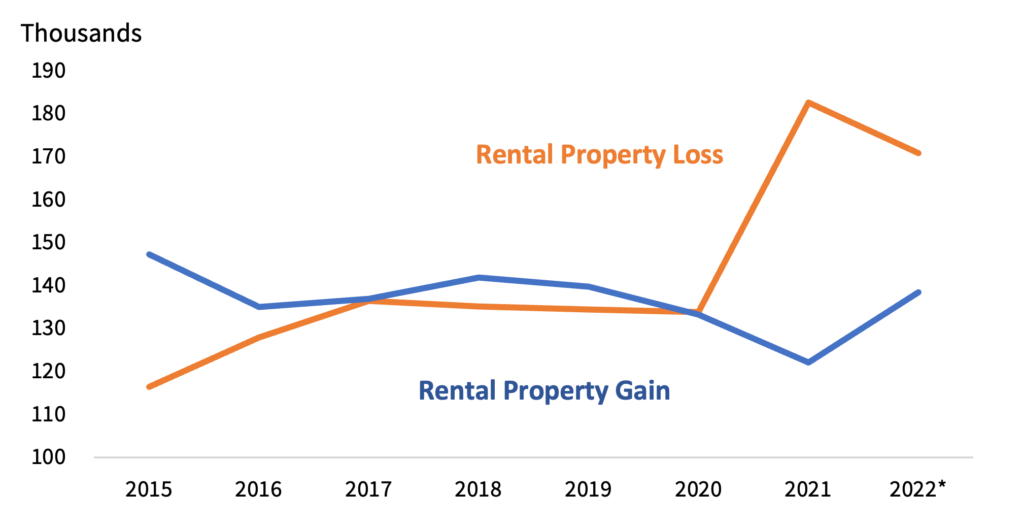
How Many Houses are Real Estate Investors Buying?
There is growing sentiment that landlords have been causing the recent rise in housing prices and that landlords have caused rents to increase as well. We hear in the news constantly that real estate investors and landlords are buying a record amount of properties. We also hear that hedge funds and institutions are buying all the homes making it impossible for the little guy to get a house. Is it true that landlords and real estate investors are overbidding and buying most of the houses? There is also a statistic that many people are missing which is how many properties are investors selling? They may be buying more, but if they are selling as well, how does that fit in? I will show you data that many others won’t about the true state of investor-owned real estate in the United States.
Are real estate investors wrecking the housing market?
A lot of the media and influencers have blamed real estate investors for ruining the housing market. They claim that real estate investors will overbid people trying to buy a home to live in, then rent out the house for way more than they should. There is even speculation that real estate investors even leave the houses vacant on purpose to push up rents or as a tax write-off.
It is true that many buyers have been overbidding on properties and prices have been increasing. However, real estate investors do not want to pay too much for a house! I am a real estate investor myself with close to 200k square feet of rentals and I have completed more than 200 flips in my career. Real estate investors used to be criticized for paying too little for houses and now we are criticized for paying too much for houses!
When I buy a rental property, I do not want to pay more than market value and then have to hope rents can be raised to make up for it. I want to buy properties that I know will rent for enough now to pay for the expenses and leave me with some profit. If the numbers do not work, I will not buy that house and I actually stopped buying single-family rentals in 2015 because they became too expensive compared to the rents that were brought in. When houses become too expensive investors stop buying rentals until rents increase to make them profitable again.
Real estate investors cannot arbitrarily raise rents. Otherwise, why aren’t rents way higher than they are now? The market determines what rents are which is based on supply and demand. The more rentals there are, the lower rent prices are because there is more competition. The fewer rentals there are, the higher rents are because there are fewer rentals for tenants to choose from. If landlords really are buying record amounts of homes, it should be helping the rental market and lowering or at least stabilizing rents, but that is not happening.
How many houses are investors buying according to the media?
The core of the investors ruining everything argument comes from the fact that investors are allegedly buying way more houses than normal. After all, investors have been around for centuries, how is it that they are just now destroying the market and they weren’t destroying it in the past? The theory is that they are buying way more houses than they used to. There is one article that claims they bought 24% of single-family homes in 2024.
This article is all over the internet and the funny thing is they showed their bias by stating these purchases drove up rents as well. However, more supply would not drive up rents, but we will get to that later. The issue I have with this article is that it states they got their data from “A Stateline analysis of data from Core Logic.” That is it, there is no link to the data or explanation of this number except to say it was 24% of single-family houses. I would love to see the data because I have seen the media and other organizations spin data like crazy. One example is when articles say that 1 in 7 houses was bought by hedge funds or Wall Street. When you read the article it says “bought by Wall Street and other investors”. In reality, hedge funds own from 300,000 to 600,000 homes out of 85 million depending on what source and metric you use.
The other issue I have with this article (besides the anecdotes saying how evil investors are for raising rents) is that other studies and sources show much lower investor purchase numbers. Redfin said there was a “record number of investor purchases in the last quarter of 2021” and they listed that record number as 18%.
https://www.nytimes.com/2022/04/23/us/corporate-real-estate-investors-housing-market.html
How many single-family homes are used as rental properties?
Another statistic people almost never use is the amount of single-family rentals over time. They do not use this stat because they are usually trying to show how investors are ruining the housing market by purchasing too many homes when the opposite is true.
Number of single-family rentals and single-family owner-occupied homes since 2010:
Year Owner Occupied Renter Occupied
2022 74,946,987.00 14,205,402.00
2021 74,072,004.00 14,318,800.00
2020 69,671,023.00 14,689,597.00
2019 69,562,011.00 14,489,715.00
2018 68,594,887.00 14,710,848.00
2017 67,787,506.00 14,947,238.00
2016 66,292,486.00 15,257,135.00
2015 65,703,475.00 15,177,698.00
2014 65,231,767.00 15,194,827.00
2013 65,064,852.00 14,881,477.00
2012 65,249,224.00 14,550,792.00
2011 65,329,282.00 13,879,578.00
2010 65,779,696.00 13,301,120.00
As you can see the number of single-family homes used as rentals has decreased by 1 million since 2016 and the number of owner-occupied houses has increased by more than 8 million in the same time frame. Investors are selling more houses than they are buying. This data is from the US census: https://data.census.gov/table/ACSDT1Y2010.B25032?q=units%20in%20structure&y=2010
(You may have to copy and paste the link above to make it work)
How many houses do large corporate landlords own?
Stats can be very deceiving because we would all assume this means investors are buying way more houses than normal. However, this just tells us the percentage of houses being bought or most likely the percentage of all housing units which includes condos and apartment buildings. It is very rare that these articles separate single-family homes from all housing units. That is why I would love to see the data from the first article. One thing we have heard over and over again is that there has been record-low inventory. If there is record low inventory investors may not be buying that many more properties than usual even though they are buying a record %.
If investors normally buy 15% of properties and there are 3 million for sale (normal inventory) that would be 450,000 houses. If there are only 1 million for sale like there have been recently and they buy 24% of those houses, that would be 240,000. “A record percentage of sales” does not mean much unless the sales are the same as they have been.
There was a study done that has been used by politicians trying to push anti-landlord housing bills that give us a much better idea of how many houses are owned by hedge funds or large corporations.
Here are some snippets from that study:
“As of June 2022, we estimate that large institutional investors own
roughly 574,000 single-family homes. We have defined an institutional investor as an entity that owns
at least 100 single-family homes. To put this in perspective, there are 15.1 million one-unit rental
properties nationwide.
This would suggest that the total institutional ownership share is 3.8 percent;
the vast majority of owners in the SFR market are small and medium investors who own less than 100
properties. There are 46.6 million total rental properties, so one-unit properties make up 32.4 percent
of the total rental stock.”
“SFR investors (mega and otherwise) make up 85 percent of the single-family properties held by
institutional operators (488,000 out of 574,000 properties) in our sample. The 32 mega investors own
almost 446,000 properties (78 percent of the total), and smaller investors and local investors own about
19,000 and 22,000 apiece (3.4 and 3.9 percent apiece). These latter groups are likely underestimated,
and our results should be regarded as a sample rather than the universe of holders. The mega operators
represent 3.0 percent of the 15.1 million total single-family properties available for rent nationwide.”
Even according to studies used by those trying to bad hedge funds and corporations from buying housing, show less than 1 percent of houses are owned by large corporations. You will hear people say that large corporations own 3.8 percent of houses, but what they really mean is 3.8 percent of rental houses, not total housing stock.
Are there more or less owner-occupants?
The stat I really like to look at is the owner occupancy rate and the number of renters and homeowners. These numbers show us who is buying and who is renting. The numbers may surprise you!

The chart is from: https://fred.stlouisfed.org/series/ERNTOCCUSQ176N. There are currently about 84 million owner-occupied housing units in the United States and about 43 million renter-occupied housing units. The really interesting thing about this chart is that it shows the number of renter-occupied housing units declining! In 2016 there were 44 million renter-occupied units and 74 million owner-occupied units. There are fewer rentals now than 6 years ago and ten million more owner-occupied units. If investors are buying all the houses, it certainly is not showing up in the US census data.
Something else to consider is the homeownership rate. A lot of people have said that homeownership which is how many homes are owner-occupied is declining, but is that true?

The chart above shows the homeownership rate is lower than it was from 2000 to 2012. However, it is now higher than at any other time before or after that (except the crazy covid bump that distorts stats). It has been increasing since 2016, which our other chart shows as well. The main reason the homeownership rate was so high in the 2000s was they made it much easier for everyone to get a loan. Subprime lending was huge and we saw how that worked out with the housing crash a few years later.
The homeownership rate is now 65.8% and it was 63% in 2016. 3% of the population is about 10 million people in the United States, which matches the increase we saw in the other chart as well. When we look at the actual numbers and not percentages of sales, we see there are many more owner-occupants now than 6 years ago, and even with a rising population, fewer renters. What else is causing the number of rentals to decrease when all we hear about is how many properties investors are buying?
Are landlords buying houses or real estate investors?
We talked about how percentages can be deceiving when looking at investors’ purchases but there is another stat that is missing in much of the data you see online. The data they pull shows all investor purchases of either homes or all properties which includes apartments and condos, etc. They have no way of knowing what type of investor is buying those properties. Is it a landlord or is it a house flipper? I flip a lot of houses and all of my purchases would be shown as an investor purchase in this data even though I am not holding them as rentals. I am fixing them up and selling them. We don’t know if the increased percentage of investor purchases are then sold again to owner-occupants.
What about all the vacant homes?
Another rebuttal to my points is that there are not more rentals because investors leave the houses empty to drive up rents and prices. I personally have never seen an investor do this unless they were planning to tear down the house at some point for development or were planning to remodel the home before renting it or selling it. I am sure it has happened before but it makes zero financial sense to leave a home vacant.
While owning a home you must pay taxes, insurance, utilities, yard maintenance, and house maintenance. A house sitting vacant is a target for vandalism and break-ins. A house sitting vacant can also attract pests, animals, and squatters. Leaving a house vacant is a massive loss to the investor. It makes zero sense even as a tax write-off because a write-off does not make up for all the money you lose.
We have all heard about the shortage of rentals and houses for sale, which makes it even dumber to leave a house vacant. There is no need to restrict supply because there has been so much demand. Finally, there are fewer vacant homes now than at almost any other time in the last 20 years.

The chart above shows all the vacant homes in the US which include houses that are being remodeled, abandoned houses, vacation houses, houses being sold, houses between tenants, and those few homes being kept vacant on purpose.
If you think those vacant homes mean we should have enough housing for everyone, you should love real estate investors like me, who buy vacant homes and fix them up to rent or sell. Those investors who are leaving them vacant on purpose are losing out on $20,000 to $30,000 a year in rent on each house. That just doesn’t add up, especially when you see the decline in vacant homes.
How many houses are investors selling?
A statistic that many people are ignoring is how many properties are being sold by investors. If investors bought 1 million homes last year but sold 2 million that is important to know. All we hear is how many they are buying, not how many they are selling.
Check out the chart below from Core Logic:

In the last few years, there have been many more rental properties sold than bought! You can also see that not that many more rentals are being bought than in the normal years before covid. This is why there is a decrease in rental properties and an increase in owner-occupied homes. The narrative that investors are buying all the homes, simply is not true.
My personal experience selling homes
We have talked about a lot of stats and scenarios but I have sold many houses myself in the last few years. I have personal experience in the market and see who is buying my houses or the houses sold in my office (I am the managing broker). Many of the articles you read are full of anecdotal stories about one family losing out to investors when trying to buy a house. I have sold about 40 house flips in the last 3 years and one of them was sold to an investor. That investor was a hedge fund but they paid less than the list price! They did not overbid or run off all the other buyers. I am in Northern Colorado and wish I had all my flips selling for $80k over the list price but that simply doesn’t happen. The rest of the house flips I have sold were sold to owner occupants, many of them using FHA financing.
As I said before, investors do not want to pay top dollar or even retail. Most investors want a good deal and are buying houses that need work, apartment buildings, or properties that have tenants who won’t leave. Owner-occupants are primarily bidding against other owner-occupants.
Conclusion
Investors are buying a high percentage of the properties for sale, at least they did last year, but that number has dropped off this year. When there is very low inventory that number does not tell us very much and we do not know whether those investors are flippers or landlords. Even with investors buying a high percentage there are many more owner-occupant households than there were 6 years ago and fewer rental households all with the population increasing. Investors can’t magically raise the prices of houses or the rent. Supply and demand raises the prices and if rent prices are too high, you should want more investors buying to supply the rental market with more choices.
Join me on The $100M Mission!
Get exclusive updates as I work to own $100M real estate by 2030 in today's market. Whether you're just starting out or already investing, you'll get actionable insights from my real-world deals and setbacks.
Plus, I'll help you set and achieve your own ambitious goals. Transform your financial future - subscribe now for weekly updates.
Together, we'll prove that massive success in real estate is still possible.